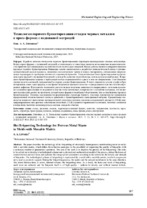| dc.contributor.author | Литвинко, А. А. | |
| dc.coverage.spatial | Минск | ru |
| dc.date.accessioned | 2023-10-20T09:52:58Z | |
| dc.date.available | 2023-10-20T09:52:58Z | |
| dc.date.issued | 2023 | |
| dc.identifier.citation | Литвинко, А. А. Технология горячего брикетирования вторичных черных металлов в пресс-формах с подвижной матрицей = Hot Briquetting Technology of Secondary Ferrous Metals in Molds with Movable Matrix / А. А. Литвинко // Наука и техника. – 2023. – № 5. – С. 367-375. | ru |
| dc.identifier.uri | https://rep.bntu.by/handle/data/136413 | |
| dc.description.abstract | В работе описана технология горячего брикетирования структурно-неоднородных отходов металлообработки в пресс-формах с подвижной матрицей, отличающаяся от известных аналогов возможностью повышения качества брикетов при минимальном количестве подготовительных операций. Целью работы является совершенствование процесса горячего брикетирования. Решаемые задачи заключаются в разработке технологической схемы и физико-математической модели процесса, снижении сил контактного трения и износа инструмента, оптимизации энергосиловых параметров по критериям плотности и прочности брикетов. Технологическая схема брикетирования представлена пресс-формой с подвижной матрицей, в которой в качестве упругой опоры используется сжатый воздух. В процессе брикетирования матрица и прессуемый металл перемещаются в одном и том же направлении. Сила бокового трения является активной, направленной в сторону усилия брикетирования. В итоге снижаются усилие и работа брикетирования, износ пресс-формы, а сам брикет получается высокого качества – однородным по плотности и без внутренних дефектов. В результате численного расчета модели получены зависимости напряженного состояния прессовки и давления прессования от координат и плотности на контактных поверхностях и в глубине материала, что позволяет производить расчет на прочность деталей пресс-формы и подобрать оборудование для осуществления процесса брикетирования. Изучены закономерности формирования структуры брикета, показаны преимущества применения предложенной технологической схемы в сравнении с брикетированием в неподвижной матрице. Предлагаемая технология исключает выполнение предварительной операции удаления смазочно-охлаждающей жидкости (СОЖ) центрифугированием или другими известными способами. СОЖ удаляется термической возгонкой, частично сжигается в топке печи, частично конденсируется в системе «мокрой» очистки. | ru |
| dc.language.iso | ru | ru |
| dc.publisher | БНТУ | ru |
| dc.title | Технология горячего брикетирования вторичных черных металлов в пресс-формах с подвижной матрицей | ru |
| dc.title.alternative | Hot Briquetting Technology of Secondary Ferrous Metals in Molds with Movable Matrix | ru |
| dc.type | Article | ru |
| dc.identifier.doi | 10.21122/2227-1031-2023-22-5-367-375 | |
| local.description.annotation | The paper describes the technology of hot briquetting of structurally heterogeneous metalworking waste in molds with a movable matrix, which differs from known analogues in the possibility of improving the quality of briquettes with a minimum number of preparatory operations. The aim of the work is to improve the process of hot briquetting. The tasks to be solved are to develop a technological scheme and a physical and mathematical model of the process, reduce the forces of contact friction and tool wear, and optimize the energy-power parameters according to the criteria for the density and strength of briquettes. The technological scheme of briquetting is represented by a mold with a movable matrix, in which compressed air is used as an elastic support. During the briquetting process, the matrix and the pressed metal move in the same direction. The lateral friction force is active, directed towards the briquetting force. As a result, the force and work of briquetting, mold wear are reduced, and the briquette itself is of high quality – uniform in density and without internal defects. As a result of the numerical calculation of the model, the dependences of the stress state of the pressing and pressing pressure on the coordinates and density on the contact surfaces and in the depth of the material were obtained, which makes it possible to calculate the strength of the mold parts and select equipment for the briquetting process. The regularities of formation of the briquette structure are studied, the advantages of using the proposed technological scheme in comparison with briquetting in a fixed matrix are shown. The proposed technology eliminates the implementation of the preliminary operation of coolant removal by centrifugation or other known methods. Coolant is removed by thermal sublimation, partially burned in the furnace firebox, partially condensed in the “wet” cleaning system. | ru |

